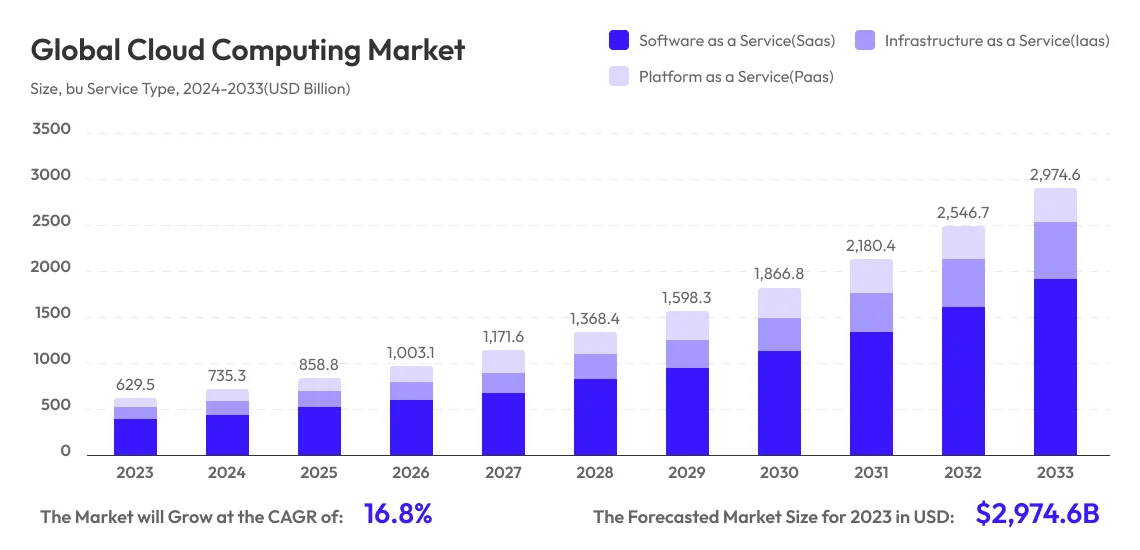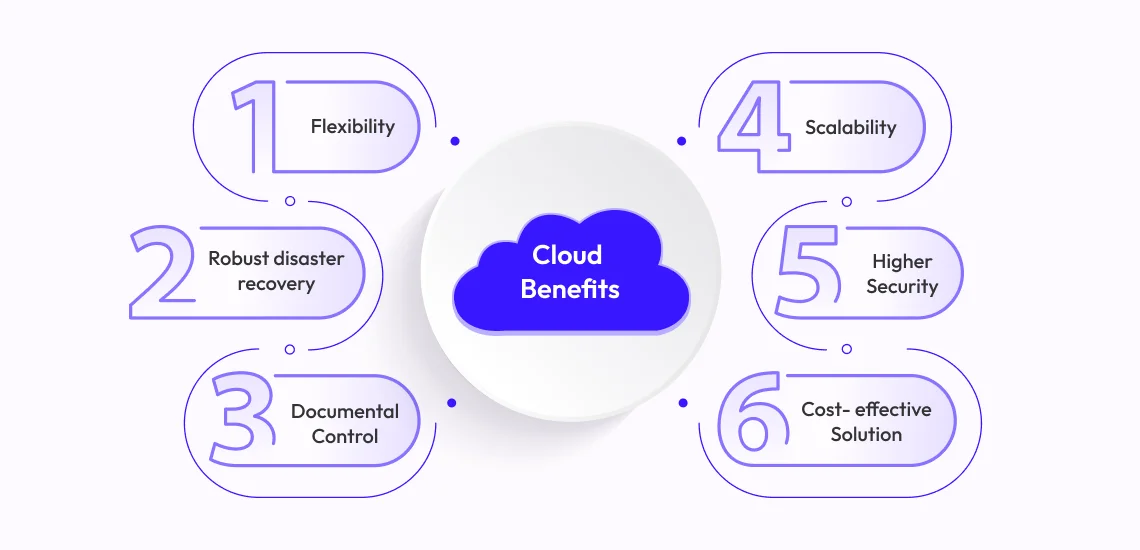What Are the Cloud Computing Benefits that Drive Business Towards Growth?
- Business
- June 3, 2024
From streamlining operations to driving innovation, cloud computing benefits can revolutionize the way organizations operate in the digital age. But the journey to cloud adoption isn’t without its challenges. That’s why we have discussed effective cloud computing adoption strategies in the blog while outlining their benefits. Read it to ensure a seamless transition to the cloud.
At present, businesses need to be smart and quick to succeed. Cloud computing helps businesses expand their capabilities, become more flexible, cut down operation costs, and facilitate collaboration with their team members and clients.
Now, you might be scratching your head, wondering, “What in the world is cloud computing? What are the prime cloud computing benefits that support your business growth and productivity? To be precise, cloud computing offers a transformative approach to IT infrastructure, providing businesses with unparalleled flexibility, scalability, and agility.
In this blog, we’ll explore the transformative advantages of cloud computing and its adoption strategy and tell you how it enables organizations to achieve their goals more effectively and efficiently.
What is Cloud Computing?
Cloud computing is a revolutionary technology that delivers computing services, including storage, databases, networking, servers, software and analytics, etc., over the internet. The technology allows users to access and utilize computing resources and applications remotely without requiring local infrastructure or hardware.
With cloud computing, users can quickly provision and scale resources on-demand, paying only for what they use. This on-demand availability of resources offers unprecedented flexibility, agility, and cost-effectiveness, enabling organizations to innovate, scale, and adapt to changing business needs with ease.

Overview of Cloud Computing Adoption in Businesses and Industries
According to various surveys and reports, the cloud computing market will obtain a valuation of $2,974.6 Billion by the year 2033 from 629.5 Billion in 2023, with a compound annual growth rate (CAGR) of 16.8% from 2024 to 2033.

In 2023, the Software as a Service (SaaS) segment acquired the position of market leader, commanding a substantial revenue share of 55.8%. The private cloud segment also exhibited dominance, capturing a significant revenue share of 43.1%.
According to another cloud computing statistic, the global cloud computing market size is projected to grow at a CAGR of 16.5% during the period 2024-2032, reaching $2.2916 trillion by 2032.
As per the latest statistics, nearly 94% organizations with a staff of 1000+ employees have adopted the cloud to handle a significant portion of their workloads.
Among different business sizes, large enterprises led the market, claiming the largest revenue share of 59.0%. Within industries, the BFSI segment stood out, securing a noteworthy revenue share of 21.5%. Geographically, North America emerged as the dominant force in the Global Cloud Computing Market, commanding a substantial revenue share of 39.3% in 2023.
Furthermore, cloud computing is segmented into Software as a Service (SaaS), Infrastructure as a Service (IaaS), and Platform as a Service (PaaS). Among IaaS, PaaS, and SaaS, Software as a Service (SaaS) emerged as the dominant player, commanding a significant revenue share of 55.8% in 2023.
This dominance is credited to the user-friendly nature and accessibility of SaaS solutions. They provide businesses with advanced applications without the hassle of managing intricate software and hardware setups.
When it comes to deployment mode, the cloud has three segments – Hybrid Cloud, Private Cloud, and Public Cloud. In these three segments, the private cloud captured a higher revenue share of 43.1% in 2023.
It dominated other types of cloud computing as it was dedicated to a single organization and offered heightened security and control features, providing better security and privacy.
If we talk about industrial adoption, the BFSI segment captured a significant revenue share of 21.5% in 2023. Cloud computing is fueling growth in the Fintech industry, Banking, Financial Services, and Insurance companies growth and revenue. The industry deals with sensitive data and requires huge storage to execute daily operations.
Along with it, cloud computing in healthcare, retail, telecommunications, media, manufacturing, and other end-user industries is also helping businesses and organizations to flourish in the competitive landscape.
5 Benefits of Cloud Computing that Help Your Business Grow
Cloud computing offers a multitude of benefits that can help your business grow and thrive in today’s competitive landscape. Here are five key advantages of cloud computing that can drive growth and innovation in your organization.

Scalability and Flexibility
With cloud computing, businesses can scale up or down their services, operations, or resources to meet the fluctuation in demand. It means they can quickly allocate additional computing power, storage, or bandwidth in peak hours and scale down the resource availability during less busy hours, saving costs and manual efforts.
Moreover, cloud-based tools and platforms empower employees to work from anywhere, irrespective of their location. It supports remote working, real-time collaboration, teamwork, immediate decision-making, information exchange, data sharing, and rapid growth.
Cost Saving
Traditional on-premises infrastructure is expensive, and you need huge capital to purchase and maintain hardware, servers, data centers, networking equipment, etc. With cloud computing, businesses can avoid these upfront costs and instead subscribe to cloud services provided by third-party vendors. This shift from capital expenditures (CapEx) to operational expenditures (OpEx) allows businesses to allocate financial resources more efficiently and focus on core business activities.
It follows a consumption-based pricing model, where businesses pay for resources and services they are using. This approach is flexible, and they can minimize or maximize consumption to avoid unnecessary expenses. Additionally, cloud providers offer various pricing plans and discounts, enabling businesses to optimize costs based on their specific needs and usage patterns.
Along with this, organizations can also save maintenance costs that they might have spent on managing traditional servers. They don’t need to look after the cloud servers, and it also supports a serverless architecture for cloud-based apps that acts as cheery on the top. All in all, cloud computing saves quite a lot of money in the long run. However, you have to pay for the implementation process, but the advantages of cloud computing makes it worthwhile.
Business Continuity and Disaster Recovery
Cloud service providers operate multiple data centers across different geographic regions, offering high availability of services. That means organizations can switch to another data center if one of the cloud provider’s data centers experiences an outage due to a power failure or natural disaster. This switch will not cause any data loss or disruption to the customers. It is considered as one of the best benefits of cloud services.
Additionally, organizations can back the critical data and applications to the cloud and secure the various copies in multiple locations. They can quickly restore the data in case of data loss, corruption, malware, or hardware failure.
Many cloud providers offer Disaster Recovery as a Service (DRaaS) solutions that enable businesses to replicate their critical workloads and data to the cloud for disaster recovery purposes. DRaaS solutions automate the process of failover and failback, allowing businesses to quickly recover their operations in the event of a disaster without the need for complex manual interventions.
Improved Security and Reliability
Cloud security is one of the prime benefits of cloud computing because cloud providers typically encrypt data both in transit and at rest to safeguard it from unauthorized access. Encryption ensures that even if data is intercepted or compromised, it remains unreadable without the appropriate decryption keys. It shields confidential data from third-party intervention and ensures compliance with data protection regulations.
Cloud platforms facilitate authentication mechanisms and access controls to confirm user identity and regulate resource and data access. Multi-factor authentication (MFA), role-based access control (RBAC), and identity management solutions help enforce least privilege principles, limiting access to only authorized individuals or systems.
Cloud providers employ advanced security monitoring tools and techniques to detect and respond to security incidents in real-time. Security information and event management (SIEM) systems, intrusion detection systems (IDS), and anomaly detection algorithms help identify suspicious activities and potential security breaches. Automated incident response mechanisms and incident response teams enable rapid containment, investigation, and mitigation of security incidents, minimizing the impact on business operations and data integrity.
Innovation
Innovation is among the prime benefits of cloud computing as it supports advanced technologies and services, including artificial intelligence (AI), machine learning (ML), big data analytics, and the Internet of Things (IoT) as managed services. These technologies are often complex and resource-intensive to implement and maintain on-premises.
Organizations can use cloud-based AI, ML, and analytics services to leverage technological advancements without investing in high-end infrastructure. They can use these technologies for innovation, predictive analytics, personalized customer experiences, intelligent automation, processing, etc.
How to Implement Cloud Adoption Strategies?
A cloud adoption strategy is a comprehensive plan outlining how an organization will transition its IT infrastructure, applications, and services to cloud-based solutions. The goal of a cloud adoption strategy is to maximize the benefits of cloud computing while minimizing risks and disruptions to business operations. The steps of cloud adoption strategies implementation are as follows:
Understand Business Goals
To begin with, it is imperative to conduct a comprehensive assessment of the organization’s current IT infrastructure. Evaluate performance, capacity, and utilization of existing servers, storage systems, and networking equipment. Organisations should know why they are adopting cloud computing. What are their end-goals and how do they plan to achieve it?
For seamless implementation, identify critical systems, dependencies, and potential areas for modernization. Also, analyzing an organization’s data landscape, including volume, variety, and governance practice is essential to understand data-related requirements.
Plan out the process of cloud computing strategy implementation and also determine cloud types. You need to choose which cloud environment you want to migrate your data and app. You can pick from multi cloud, hybrid cloud, private cloud or public cloud.
Identify Potential Risks
During the process, you need to ask, what are the potential risks of migrating data and applications to the cloud? Could there be data breaches, unauthorized access, or compliance violations? Also, consider factors like encryption, access controls, and compliance requirements to mitigate security risks effectively.
You must demonstrate compatibility and interoperability risks with existing systems and workflows. There could be data silos, integration complexities, or disruptions to business processes. Hence, before implementing cloud adoption strategies, mitigate potential risks to avoid damage in the future.
Work on Proof of Concept
Design the architecture of the PoC environment, considering scalability, high availability, and disaster recovery. After the architecture design, set up the PoC environment by provisioning and configuring cloud resources.
Migrate or deploy the workload, application, or use case to the cloud environment to implement the PoC. Test the PoC to address challenges and assess factors, including performance, user experience, functionality, scalability, and cost-effectiveness.
Migrate Data
Before proceeding to cloud migration, clean, transform, and validate data to prepare it for migration. You can use data cleansing activities, like deduplication, data quality checks, normalization, etc., to find and fix errors or inconsistencies. Now, choose the appropriate migration approach after evaluating significant aspects such as the data volume and complexity, downtime tolerance, and budget constraints.
You can choose offline migration and transfer the data in bulk with the help of tools like AWS Snowball or Azure Data Box and online migration, where data is migrated incrementally over the network using services like AWS Database Migration Service or Azure Data Migration Service. Once the data is prepared, you can migrate it to the cloud environment according to the migration plan.
During the migration process, monitor progress, track performance, and address any issues or challenges by adjusting migration parameters, troubleshooting connectivity issues, or optimizing data transfer methods.
Migrate Application
To migrate the app, choose a migration approach from the common ones like rehosting (lift and shift), re-platforming (lift, tinker, and shift), refactoring (re-architecting), and rebuilding (re-platforming with cloud-native technologies). Pick according to your requirements, budget, and time.
Prepare the app for migration, update application code, configure cloud infrastructure, and test functionalities in the cloud environment. At the time of migration, be cautious, follow the process properly, and avoid incompatibility issues.
Scale Features
Leverage managed services, including databases, machine learning, analytics, etc., to offload operational tasks and improve scalability. Organizations can also apply auto-scaling and load-balancing mechanisms to adjust resources based on demand dynamically. Scale its features to enhance functionalities and make it more useful for the organization.
Optimize Cloud Performance
Monitor and analyze the performance of their cloud-based applications and infrastructure. It includes tracking key performance metrics such as response times, throughput, and resource utilization to identify bottlenecks and areas for improvement. Fine-tune application configurations, adjust cloud resource allocation, and optimize data storage and retrieval processes for better output.
By following these steps and best practices for cloud adoption strategies implementation, organizations can maximize the value of their cloud adoption efforts and ensure that their cloud-based applications perform efficiently and effectively in the cloud environment. However, you need to hire dedicated remote developers and reliable cloud solution providers to implement the strategy.

How Can MindInventory Help You Reap the Benefits of Cloud Services?
MindInventory’s expertise in cloud computing technologies, combined with its proven track record of delivering innovative and scalable solutions, makes it the ideal digital transformation partner for businesses seeking to leverage the power of the cloud.
Our experts possess deep knowledge and expertise in leading cloud platforms such as Amazon Web Services (AWS), Microsoft Azure, and Google Cloud Platform (GCP). You can hire dedicated remote developers from our team whether your business requires cloud migration, infrastructure design, or application development services.
MindInventory offers end-to-end cloud services, including cloud strategy consulting, cloud migration, application modernization, and cloud-native development. From assessing your current IT infrastructure to designing and implementing cloud-native architectures, our team guides you through every step of your cloud adoption journey, ensuring a seamless and successful transition to the cloud.
FAQ on Cloud Computing
Businesses choose a multi-cloud strategy to avoid vendor lock-in, mitigate risks, and leverage geographic reach and specialized services while reducing costs. Multi-cloud architecture helps businesses maintain flexibility, reduce downtime impact and service disruptions, access a wider range of services, and ensure compliance with regulatory standards.
The four main stages of cloud adoption are – planning, migration, implementation, and optimization. The adoption requires updates from time to time. You’ll have to take care of the updates to maintain cloud computing.
The prime benefits of cloud computing in business include cost savings through reduced infrastructure and operational expenses, scalability to accommodate fluctuating demand, enhanced agility to respond quickly to market changes, improved collaboration and accessibility, and access to advanced technologies and resources without significant upfront investments.













